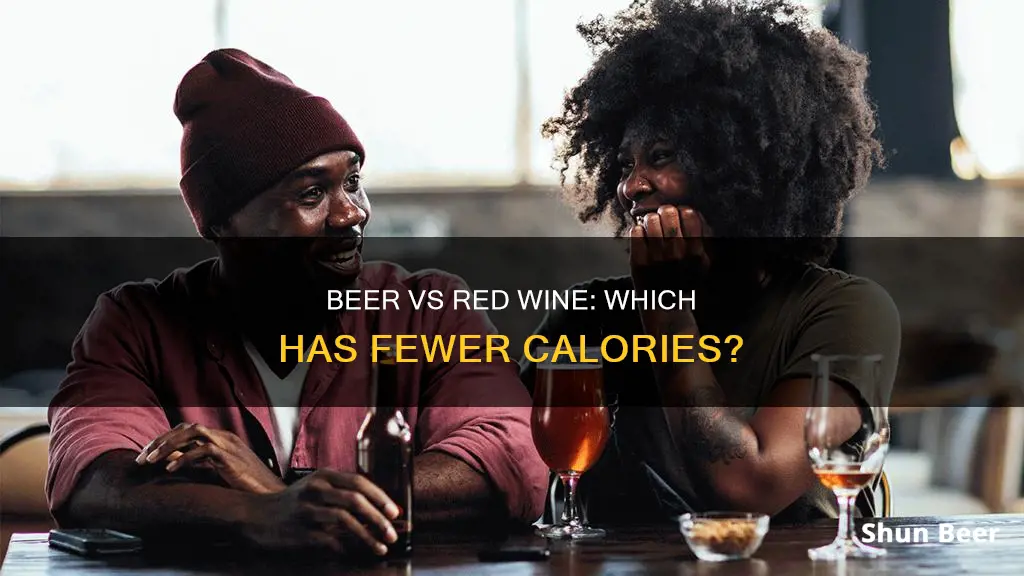
Alcoholic drinks are not required by the FDA to list their nutritional content, making it difficult to compare the calories in beer and wine. Generally, beer has more calories than wine, but this is not always the case. The calorie content of both drinks depends on several factors, such as alcohol and carbohydrate content, serving size, and the type of beer or wine.
| Characteristics | Values |
|---|---|
| Calories in a 5% ABV pint of beer | 239-240 kcal |
| Calories in a 12% ABV 175ml glass of wine | 133 kcal |
| Calories in a bottle of red wine | 632 kcal |
| Calories in a bottle of white wine | 607 kcal |
| Calories in a 12% ABV glass of wine | 133 kcal |
| Calories in a 5% ABV pint of beer | 239 kcal |
| Calories in a light beer | 55-100 kcal |
| Calories in a bottle of champagne | 570 kcal |
| Calories in a glass of champagne | 84 kcal |
What You'll Learn
- Red wine has 25 calories per ounce, while white wine has 24
- Beer is made from grains and has more calories than wine
- Wines vary in their carb content, primarily in the form of residual sugar
- Beer is usually served in higher volumes than wine
- Red wine contains antioxidants, which can improve heart health

Red wine has 25 calories per ounce, while white wine has 24
When it comes to calories, red wine and white wine are pretty close. Red wine has 25 calories per ounce, while white wine has 24. That means that per 750ml bottle, red wine has 632 calories, and white wine has 607.
Red wine tends to have a higher calorie count because it is fermented with older, more sugary grapes, with the skin left on. This leads to the creation of more tannins and a higher ABV due to the sugar content. The tannins in red wine are also what cause its deep red colour.
White wines tend to be lower in calories than reds, and wines with lower alcohol by volume (ABV) will also have fewer calories. The higher the ABV, the higher the calorie count. So, if you're watching your weight, white wine is a slightly better choice than red.
However, red wine is the better choice if you're looking for health benefits. Red wine contains more antioxidants than white wine, which can help protect your heart and improve cholesterol levels. Doctors have linked these antioxidants to improved heart health and a decreased risk of developing certain types of cancer, and they've also been found to support weight loss.
Of course, it's important to remember that alcohol consumption is linked to weight gain, especially when consuming large amounts, due to the empty calories and carbohydrates. So, as with all indulgences, the trick is to consume your wine in moderation.
Calories in Amber Bock Beer: Nutritional Facts and More
You may want to see also

Beer is made from grains and has more calories than wine
Beer and wine are two of the most popular alcoholic drinks, but they differ in flavour, nutritional value, and ingredients. Beer is made from grains and yeast, and while it has a higher nutritional value than wine, it also has more calories.
The calorie content of beer varies depending on the type. Lighter beers tend to have a lower alcohol content and ingredient density, resulting in fewer calories. For instance, light beers typically have between 60 and 120 calories. On the other hand, dark beers, which are more carbohydrate-heavy, can contain anywhere from 100 to 300 calories. The colour of the beer is a good indicator of its calorie content, with lighter-coloured beers generally containing fewer calories than their darker counterparts.
Wine, on the other hand, has a lower calorie content. A standard 175ml glass of 12% ABV wine contains approximately 133 calories, which is equivalent to about three Jaffa Cake biscuits. The type and colour of wine also impact its calorie content. Red wine, for example, tends to have a higher alcohol content and thus more calories, with 75-85 calories per 100ml. White wine has slightly fewer calories, ranging from 73 to 83 calories per 100ml, while rosé wine typically falls between 70 and 80 calories per 100ml.
The difference in calorie content between beer and wine can be attributed to the leftover carbohydrates in beer. Wine, in comparison, usually has a relatively low sugar content. Dwayne Bershaw, a winemaking instructor at Cornell University, explains that the remaining carbohydrates in beer contribute significantly to its overall calorie count.
While beer may have more calories, it is important to note that both drinks can vary widely in their calorie content. Additionally, the expression "beer belly" may not be entirely accurate, as a 2015 review of studies found that neither wine nor beer drinkers tend to gain weight in the short term. Nevertheless, for those conscious of their calorie intake, wine may be the better choice, as it typically has fewer calories per serving than beer.
Calorie Count in Hoptimum Beer: Everything You Need to Know
You may want to see also

Wines vary in their carb content, primarily in the form of residual sugar
The average glass of wine (approximately 5 oz) has anywhere from 0 to 4 grams of carbohydrates. Wines with more residual sugar will taste sweeter, and wines with less residual sugar will taste drier. Red wines tend to be dry, whereas white wines tend to be sweeter. However, there are some popular sweet red wines, and dry white wines are also extremely popular. In general, a white and red wine with the same residual sugar content will have a similar carb content.
The amount of residual sugar in wine is usually displayed in grams per liter (g/L), grams per 100ml, or as a percentage. Wines can range from 0 to 220 grams of sugar per liter, depending on the style. For example, a bone-dry wine will have less than 1 sugar calorie per glass, whereas a very sweet wine will have 72-130 sugar calories per glass.
It's important to note that humans are relatively bad at detecting sugar in wine with their taste buds alone. Even highly trained wine tasters often struggle to identify residual sugar in wine, but it is a skill that can be learned with practice. Additionally, wineries are not legally required to list sugar levels on wine bottles, so it can be challenging to determine the exact sugar content of a particular wine. However, some wineries provide technical sheets that include important information such as the residual sugar level of each vintage.
Heineken Zero Beer: Calorie-Free Refreshment
You may want to see also

Beer is usually served in higher volumes than wine
When it comes to calories, beer and wine are not created equal. While beer and wine have distinct differences in flavour, nutritional values, and ingredients, beer is often served in higher volumes than wine, which can impact the number of calories consumed.
In the United States, a standard serving of beer is typically 12 ounces, or about the size of a bottle of beer. A pint of beer, on the other hand, is generally 15 ounces, which is larger than the standard serving size. The alcohol by volume (ABV) in beer can range from 4-7%, with an average of 5%. Therefore, a 12-ounce beer at 5% ABV equals 0.6 ounces of alcohol per serving. However, if you opt for a craft beer, such as an IPA, the alcohol content per serving can be closer to 0.9 ounces.
Now, let's compare that to wine. A standard serving of wine is typically 5 ounces and contains between 11-13% ABV. However, it's important to note that not all wines are created equal. The alcohol content can vary depending on the type of wine. For example, white wine usually has an ABV of around 10%, but it can range from 5% to 14%. Red wine, on the other hand, tends to have a higher alcohol content, ranging from 12% to 15%. So, a 5-ounce pour of white wine will likely contain less alcohol than a 5-ounce pour of red wine.
When it comes to calories, a standard 175ml glass of 12% ABV wine contains around 133 calories. The type and colour of wine can also make a difference. Rosé wine, for instance, has around 70-80 calories per 100ml, while white wine has 73-83 calories, and red wine typically falls between 75-85 calories per 100ml. This variation is due to red wine's higher alcohol content; wines with higher alcohol content tend to have more calories.
On the other hand, a pint of 5% ABV beer contains approximately 240 calories. The calorie content of beer can vary widely depending on the type. Lighter colour beers tend to be lower in calories than darker beers due to their lower alcohol content and ingredient density. Light beers usually have between 60 and 120 calories, while dark beers can pack in 100 to 300 calories. So, while a standard serving of wine may have fewer calories than a standard serving of beer, the higher volumes in which beer is typically served can result in a higher calorie intake.
It's worth noting that the nutritional value of beer surpasses that of wine. Beer often contains protein, fibre, B vitamins, folate, and niacin, which are not present in wine. Additionally, research has shown that wine enters the bloodstream more quickly than beer, leading to a faster onset of intoxication.
In conclusion, while beer is usually served in higher volumes than wine, the calorie content of each drink can vary depending on various factors such as alcohol percentage, type, and ingredients. To make informed choices, it's essential to understand the differences in serving sizes and nutritional values between beer and wine.
Calorie Count of Red Trolley Beer: Know Before You Drink
You may want to see also

Red wine contains antioxidants, which can improve heart health
While beer and wine have distinct differences in flavour, nutritional values, and ingredients, it is challenging to determine which of the two contains fewer calories. This is because the calorie content of each drink can vary depending on factors such as alcohol percentage, colour, and type.
On average, a pint of 5% ABV beer contains around 240 calories, while a standard 175ml glass of 12% ABV wine contains approximately 133 calories. However, when comparing by volume, wine tends to have a higher calorie count than beer. For instance, red wines have 25 calories per ounce, while white wines have 24.
Despite the variation in calorie content, neither drink can be considered a healthy option, as excessive alcohol consumption is linked to various health risks. However, red wine does contain antioxidants, which can improve heart health.
Red wine, made from crushed dark grapes, is a rich source of resveratrol, a natural antioxidant found in the skin of grapes. Antioxidants help to reduce oxidative stress in the body, which has been linked to cancers and heart disease. The Mediterranean diet, known for its heart-protecting properties, often includes red wine.
While some studies suggest that moderate red wine consumption can improve heart health, the evidence is not conclusive. For example, a review article in the October 10, 2017, issue of Circulation found that some studies indicate wine is better for the heart than beer or liquor, while others do not. Additionally, the positive health effects associated with red wine may be due to other factors, such as lifestyle and dietary differences, rather than the wine itself.
Furthermore, while resveratrol has been heavily advertised as a heart-protecting supplement, there is little evidence of its benefits for humans. A 2014 study of older adults in Italy, whose diets were naturally rich in resveratrol, found no link between resveratrol levels and rates of heart disease, cancer, or death. Similarly, a 2015 review reported that resveratrol might help protect against secondary brain damage after a stroke or central nervous system injury, but these effects were specific to resveratrol rather than red wine.
In conclusion, while red wine contains antioxidants that may offer potential health benefits, it is important to consume it in moderation. Moderate drinking is generally defined as one drink per day for healthy women and two drinks per day for healthy men. Additionally, older men over the age of 65 should limit their alcohol intake to no more than one drink per day due to age-related changes in alcohol metabolism.
Estrella Beer Calories: What's the Count?
You may want to see also
Frequently asked questions
Red wine has fewer calories than beer. A 750ml bottle of red wine has 632 calories, while a pint of 5% ABV beer contains around 240 calories.
A 150ml glass of red wine has 80-140 calories, while a 125ml glass has 70-85 calories.
A 750ml bottle of red wine has 632 calories.
A pint of 5% ABV beer contains around 240 calories.
Yes, the colour and type of wine, as well as the style of beer, can affect the calorie content. Lighter colour beers tend to contain fewer calories than darker beers, and red wine tends to have a higher alcohol content than white wine, which contributes to a higher calorie count.







